How to Mix Kettlebells the Spartan Way, Interview with Joe DiStefano, Spartan Race, RKC
By Adrienne Harvey, SrPCC, RKC-II, CK-FMS
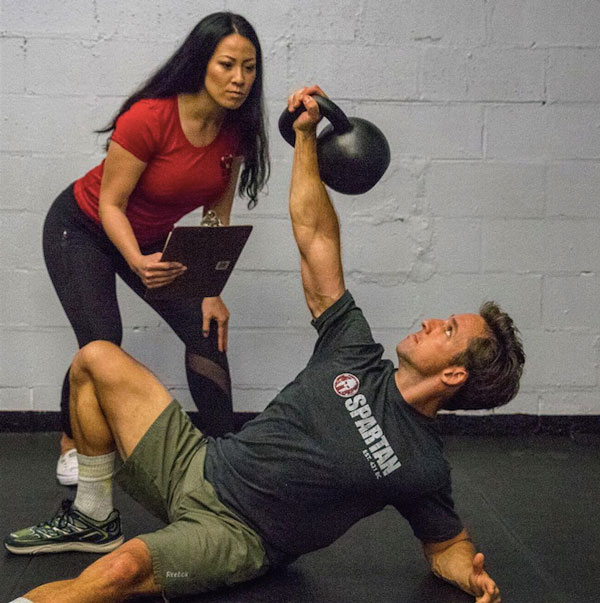
Dragon Door: It sounds like you've been involved in fitness and athletics for quite a while. How did you originally get started?
Joe DiStefano: It's kind of a funny story. I grew up playing sports and played baseball for many years. But, when I was in middle school I really got into skateboarding. Even though baseball was my life, and I had been swinging a bat since I was two, I had the most success with skateboarding. I even racked up a few sponsors, and went to competitions. Both baseball and skateboarding are pretty explosive sports. For baseball, I had to maintain a 7:40 mile for my entire career. I never really got into endurance sports, and in fact I couldn't stand running.
Since I hadn’t really applied myself in high school, I knew wasn't going to get into an ivy league school. So, I just applied to a couple of state schools and ended up getting in. I was undeclared at first, but since I thought I might want to start a t-shirt business, I started taking a few business classes. This was how I met a then-new professor, Dr. Jeff Godin, who has since become a department head.
In some random conversation he said, "I’m doing a 100 miler this weekend!" I remember thinking, 100 miles? What are you talking about? Like in a car? On a bike? No, he was running those 100 miles. At the time I thought the human body couldn’t sustain more than 26.2 miles, so I was totally intrigued. It also made me a little mad—if he could run 100 miles, I could do a half-marathon. Soon after (in 2004) I did a half-marathon in Hyannis and thought it was kind of fun. I ended up switching my major to exercise physiology. Dr. J and I are still really close friends. We do events together and travel together.
Dragon Door: How did you start your fitness training career?
Joe DiStefano: In 2003, had just started college. I got a $6 an hour job working in a gym. I was just taking out the trash and keeping the treadmills running. I saw that the personal trainers were putting people through a Nautilus circuit all day and then splitting $52 an hour with the gym! I thought I could do that.
Even though I didn’t have a degree, neither did any of those trainers who were making three times as much as I was! I studied and passed the NASM test, then trained my first client, Randy, in the Winter of 2003. This big box gym was in a high income area, and all the other personal trainers had been in the club for a long time.
With my NASM certification, I had people standing on one leg, and doing really novel exercises in their workouts. Because I had recovered a traumatic brain injury and done a lot of rehab with movement and developmental kinesiology, my view of training was already much more "functional." When I was fixing my brain, I had to crawl—I also realized that crawling and other basic movements could be a great workout.
Because my training worked—and looked novel and exciting—I quickly became a very successful
personal trainer. I was training clients for 35-40 hours a week during my last three years of college.
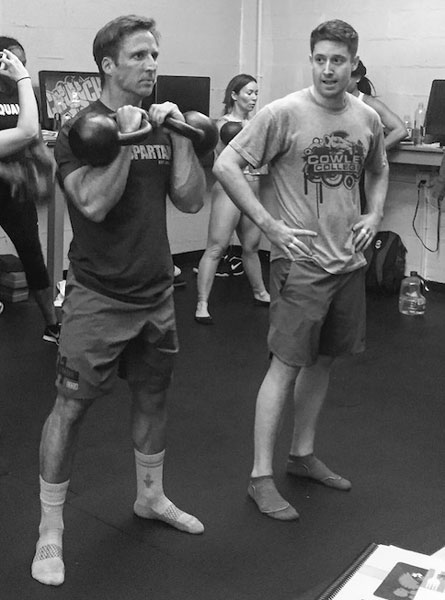
While I was training clients full time, and going to school full time, I was also running 50-75 miles each week. Dr. J got me hooked on running, so I wanted to do an Ironman and many other events. But after I graduated, my structure fell away. I had always been under the gun training people at 5AM, 6AM, and 7AM before going to my 9AM class. I had classes from 9AM until 2PM, then I'd continue training people from 3PM to 7PM.
But when I suddenly had more time on my hands after graduating, I ended up running more and completely burning myself out. I was just doing way too much and had to take a break. I took six months off and traveled to the Caribbean. I didn’t know what to do with my life and needed this weird "come to Jesus" time. People couldn’t understand how I could just walk away from what I had been doing.
When I came back, all my clients were ten pounds heavier than before I left! So, when I opened my own gym, the response was immediate. The time away had actually tightened my relationships with all my clients. The gym was
successful relatively quickly, and I ran that for a couple of years. I mainly trained throwing athletes, baseball players, tennis players, and general population clients.
A few years later, I had an opportunity to help develop a coaching-based franchise, so I sold my gym to take on that role. Then, Spartan started in 2010. To be honest, I did both because I wasn't sure if Spartan was going to be successful. I started with Spartan on Tuesday nights, which became Tuesday and Thursday nights, and finally Tuesday, Thursday, plus the weekends before I eventually gave up my franchise gig. Now, here I am seven years later!
Dragon Door: What were you doing with Spartan at first?
Joe DiStefano: When I was getting into endurance races with Dr. J in around 2004, He invited me to an event called Death Race. It didn’t sound attractive to me. I knew what to expect from other events like half marathons—I knew I could train and show up prepared with my carbs, salt, and heart rate monitor. But with Death Race, you didn’t know what you would be doing until the day of the event. I thought that was a completely bogus concept at the time. But Dr. J did it every year—and told me I should do it every year.
In 2010, Dr. J said, "The lunatic who puts on the Death Race just started a new race called Spartan, it’s only a 5k and you’re going to be throwing spears!" I decided I could handle that. I did the race and had fun—it was what I needed. I really liked the strength training aspect since longer runs had been burning me out again. Spartan was the perfect mix. At the time though, Spartan was just eight dudes sitting around a table in Vermont. For the first two and a half years, there were only five Spartan races. Until about 2012, the Spartan company was basically the same eight dudes. No one was a full time employee, and we had no way of knowing that Spartan would soon become a million person, thirty country mass-participatory phenomenon attached to a valuable business. It was a hobby. But, in 2012 we jumped to 35 races, and then to 50 the next year. Once we hit 35, we knew it was the real thing.
Dragon Door: What's your official title at Spartan? I saw it listed a few different ways...
Joe DiStefano: My title has changed so many times over the years, but right now, I am the director of training and sport initiatives. So I do or oversee anything relatively new, or any innovations we want to add to our training products or our sport.
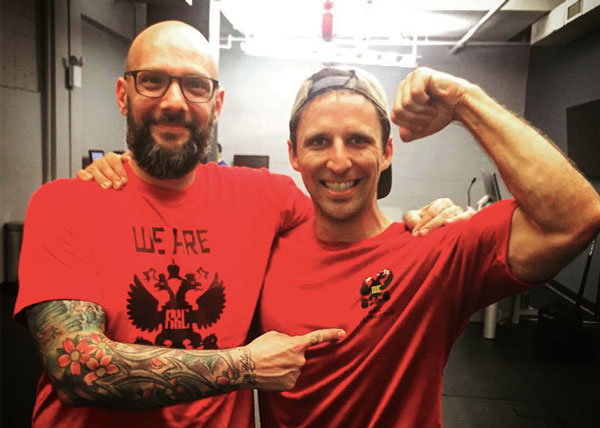
Dragon Door: What brought you to the RKC?
Joe DiStefano: Going to rewind a bit. Several years ago, I had a really bad head injury. It fractured my skull and I had to have a plate put in my head. Even now I still see doctors about one to three times a month to stay ahead of my body and mind. Because of my head injury, I have a slight "traffic jam" in my neck, even though my right and left side look symmetrical and no one can really tell I have any issues. But, if I am walking next to someone down a long straight hallway, I’ll slowly walk into them if they’re on my right side. Basically, my alignment is just a little bit off, and if I get super stressed, don’t eat right, don’t train properly, or don’t move enough then my body—there’s no other way to describe it—"Quasimodos". I have to stay outrageously active and it’s also very important that I stay relaxed.
I got my CrossFit level one certification in 2006 and especially back then, it was all barbells, pull-ups. Even though I was a fitness expert, I "drank the Kool-Aid" even though this modality’s intensity was the worst possible thing for my body—physically and neurologically. Because of my slight asymmetry, there’s no way I can really progress with barbell training—after a point it will only harm me.
After a few years of pain, shoulder injuries, ending up at my neurologist’s, and spending a lot of time trying to figure myself out, I found the problem—it was the barbell, especially overhead.
A friend of mine who was running a kettlebell certification at the time told me to just start
carrying kettlebells. He said to carry them at my side, in the rack, and to try carrying them overhead. After two years of carrying kettlebells, he taught me how to swing. I got really into it and learned how to do kettlebell squats and snatches. I even went to the RKC about five years ago, but I failed because I didn’t pass the
snatch test.
Dragon Door: Oh no! What happened?
Joe DiStefano: This was five years ago in Boston, and I had signed up just a couple of weeks before the event thinking that I'd be fine to pass. It’s kind of funny, and I even discussed that experience in one of the articles I recently wrote for
Dan John. I failed the RKC and was so mad at Dragon Door because I weighed 158lb and every guy had to test with the
24kg kettlebell. I felt like it was impossible and that there’d never be a male RKC who weighed less than 175!
I felt like I watched a bunch of guys with an 1/8 of my experience get certified, and I didn’t know how to handle it. I had never failed anything like that in my life—especially not something I expected to do well at. Maybe it was a case of running up against an "everyone gets a trophy" mindset, because I hadn’t really done the work. I feel like Millennials and my interns have to learn that if you don't do the work then you don't get the cake! But, I ended up feeling very thankful because the RKC taught me a lot through that experience.
When I signed up this year—and saw that Dan John was teaching it—I took it so seriously because I was not going to fail in front of Dan John! I trained pretty hard, and tried to do whatever it would take. When I got to the workshop, I found out that because I weighed under 160lb, I could now test with the
22kg kettlebell. Since I was mentally and physically ready (although still a little worried about it) to test with the 24kg, I was very relieved to find out that I would test with the 22kg.
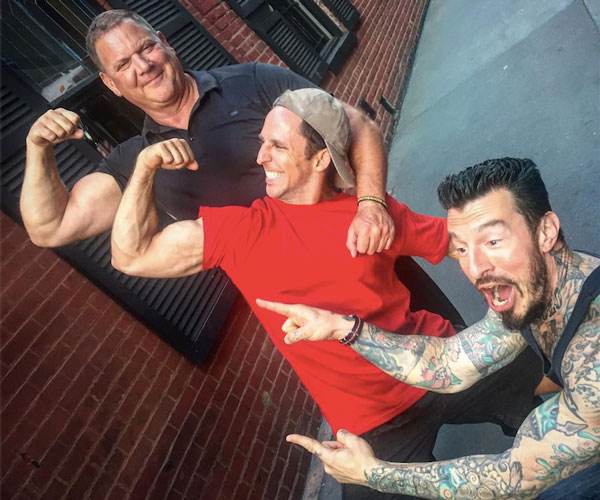
Now, the only training I do with a barbell is the occasional
deadlift—and that’s just when I’m training with friends. Otherwise my training is just
kettlebells, running, hiking, fan bike, and
bodyweight exercises.
Dragon Door: How did you first learn about Dan John?
Joe DiStefano: I have always had a lot of respect for Dan. I think back in the day actually, Dr. J. had some Dan John books. Over the years, I went to Perform Better seminars, had a brief internship at Mike Boyle's gym, and spent a lot of time at Eric Cressey's gym as a paying customer. I was definitely excited to meet Dan John at the recent RKC. It was a lot of fun. We chatted over beers two out of three nights of the event, so I got to know him pretty well.
He is just such an amazing instructor and I have so much respect for him. I've taught over a hundred two-day workshops, so when I see a great teacher and presenter, it really blows me away. I spend a lot of time trying to be my best—and content aside, presentation is everything. Along with Dan John’s experience and knowledge, he has the ability to really delivery it during the RKC. The
RKC is a long three days, but when we’re enjoying every minute of it, it says a lot about the instructors.
Dragon Door: What was your favorite thing about the RKC... this time around?
Joe DiStefano: This time it was the snatch test—because I actually passed it, and on day one! Right before a break, Dan asked if anyone wanted to get it out of the way. I knew I was in my prime on that first day, so I went ahead and did the test.
The RKC was such a great time, and I would do it again. You really get to know a lot of really amazing people. I enjoyed the partner activities and tried to work with and get to know many different people.
It was also a lot less of a beatdown this time. It was still hard, but Dan trickled in the
workouts in a way that was planned and which made sense in the context of the three days. The workouts weren't just about beating the heck out of us. Sure, we were tired afterwards, but we still felt good and were ready to rock and roll the next day. I’m glad the mindset has shifted, because at that earlier RKC, I remember leaving just beat to the ground each day. Now, you still get tired but are optimistic and eager to come back.
Dan's anecdotes and experiences are great teaching tools—and no matter what mistake you're making now, he's seen it before. He’s worked with so many athletes, and his own career as an athlete was longer than most in his sport.
I wrote down several of his one-liners over the weekend. It’s a profound when someone like Dan John says that if he knew then what he knows now, he never would have back squatted with a barbell. He won a national championship and spent thirty years under a barbell!
Dragon Door: He's an incredible instructor, I always feel like I am learning on at least two levels with him.
Joe DiStefano: A friend was teaching a two hour kettlebell clinic at his gym, and I went by to hang out and participate. But, I think the biggest battle for people—and for us as instructors—is that everyone on the planet thinks they know how to swing a kettlebell. Even though I've been swinging kettlebells for many years, I still got a lot of value from this two hour clinic intended for desk jockeys trying to learn to swing for the first time.
A group of guys came to the workshop because they wanted to learn how to snatch kettlebells. They said they already knew how to do
get-ups and swings, and that they just wanted to learn snatches. But, it was soon obvious that they did not know how to do swings or get-ups. I think that no matter who you are or how long you've been swinging a kettlebell, there's still so much more to learn. Accepting that fact is the biggest thing you can do for yourself and your clients. And that even goes for professional athletes!
Dragon Door: Do you think kettlebell training is specifically useful when preparing for events like Spartan Race?
Joe DiStefano: Yes, in my opinion
kettlebell training creates far better athletes than other modes of training. Not to mention that with Spartan, grip is one of the biggest challenges on the course. We do top loaded carries with sandbags, front loaded carries with buckets, farmers carries with logs with chains on them, and weighted drags. It's very grip intense.
I’m currently training twenty pro team athletes. Almost all of them warm up—depending on what’s available at their gym—with at least 10-15 minutes on the ski-erg or the fan bike because they’re already running a ton. Then, they do a 3-10 minute light weight mixed up carry for mobility work. For example, they might grab two
12kg kettlebells and then they won’t put them down for ten minutes. Even though the kettlebells aren’t heavy, the athletes are moving around with them the whole time—they might do two minutes in a farmer’s carry, then rack positions, then maybe a few shoulder presses, then back to farmer’s—just as long as they’re moving.
Next, we go into a lot more mobility work, which might seem a little backwards. But, it’s been working really well because many of the athletes need to "turn on their breath." When you’re using lighter weights and in goblet carry position, or a double rack position and just walking, you’re constantly nose breathing and funneling the breath. I think that creates a better abdomen to move from, so when we start our mobility exercises like downward dogs, haloes, and whatever everything is already lit up.
We do swings, but we also use a lot of snatches in their workouts, too. Since many of the pro team athletes are CrossFit converts, they’re used to doing the American swing which is really a two handed snatch. So, in our training we just have them take one hand off the kettlebell. In general we do a lot of snatches, swings and carries.
Dragon Door: Before the call, you mentioned that you were flying out to Barcelona, what's next on your agenda?
Joe DiStefano: I have the European championship this weekend in Andorra, so I am going to Barcelona and then to the European championship. After that, I am going to Luxembourg to meet some people and do a little bit of training. Then I am going to Tahoe for the world championship. One week after that, I will be teaching an event in Miami on South Beach. So when I leave tomorrow morning, I won’t be home for over a month!
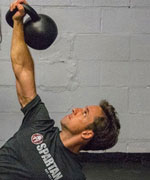 Joe DiStefano, RKC, is the Director of Training and Sport Initiatives at Spartan. Follow him on Instagram: @CoachJoeDi
Joe DiStefano, RKC, is the Director of Training and Sport Initiatives at Spartan. Follow him on Instagram: @CoachJoeDi
Back